Zhen Wu
Zero-Shot Human-Object Interaction Synthesis with Multimodal Priors
Mar 25, 2025Abstract:Human-object interaction (HOI) synthesis is important for various applications, ranging from virtual reality to robotics. However, acquiring 3D HOI data is challenging due to its complexity and high cost, limiting existing methods to the narrow diversity of object types and interaction patterns in training datasets. This paper proposes a novel zero-shot HOI synthesis framework without relying on end-to-end training on currently limited 3D HOI datasets. The core idea of our method lies in leveraging extensive HOI knowledge from pre-trained Multimodal Models. Given a text description, our system first obtains temporally consistent 2D HOI image sequences using image or video generation models, which are then uplifted to 3D HOI milestones of human and object poses. We employ pre-trained human pose estimation models to extract human poses and introduce a generalizable category-level 6-DoF estimation method to obtain the object poses from 2D HOI images. Our estimation method is adaptive to various object templates obtained from text-to-3D models or online retrieval. A physics-based tracking of the 3D HOI kinematic milestone is further applied to refine both body motions and object poses, yielding more physically plausible HOI generation results. The experimental results demonstrate that our method is capable of generating open-vocabulary HOIs with physical realism and semantic diversity.
Counterfactual Language Reasoning for Explainable Recommendation Systems
Mar 11, 2025Abstract:Explainable recommendation systems leverage transparent reasoning to foster user trust and improve decision-making processes. Current approaches typically decouple recommendation generation from explanation creation, violating causal precedence principles where explanatory factors should logically precede outcomes. This paper introduces a novel framework integrating structural causal models with large language models to establish causal consistency in recommendation pipelines. Our methodology enforces explanation factors as causal antecedents to recommendation predictions through causal graph construction and counterfactual adjustment. We particularly address the confounding effect of item popularity that distorts personalization signals in explanations, developing a debiasing mechanism that disentangles genuine user preferences from conformity bias. Through comprehensive experiments across multiple recommendation scenarios, we demonstrate that CausalX achieves superior performance in recommendation accuracy, explanation plausibility, and bias mitigation compared to baselines.
PersuasiveToM: A Benchmark for Evaluating Machine Theory of Mind in Persuasive Dialogues
Feb 28, 2025Abstract:The ability to understand and predict the mental states of oneself and others, known as the Theory of Mind (ToM), is crucial for effective social interactions. Recent research has emerged to evaluate whether Large Language Models (LLMs) exhibit a form of ToM. Although recent studies have evaluated ToM in LLMs, existing benchmarks focus predominantly on physical perception with principles guided by the Sally-Anne test in synthetic stories and conversations, failing to capture the complex psychological activities of mental states in real-life social interactions. To mitigate this gap, we propose PersuasiveToM, a benchmark designed to evaluate the ToM abilities of LLMs in persuasive dialogues. Our framework introduces two categories of questions: (1) ToM Reasoning, assessing the capacity of LLMs to track evolving mental states (e.g., desire shifts in persuadees), and (2) ToM Application, evaluating whether LLMs can take advantage of inferred mental states to select effective persuasion strategies (e.g., emphasize rarity) and evaluate the effectiveness of persuasion strategies. Experiments across eight state-of-the-art LLMs reveal that while models excel on multiple questions, they struggle to answer questions that need tracking the dynamics and shifts of mental states and understanding the mental states in the whole dialogue comprehensively. Our aim with PersuasiveToM is to allow an effective evaluation of the ToM reasoning ability of LLMs with more focus on complex psychological activities. Our code is available at https://github.com/Yu-Fangxu/PersuasiveToM.
Rethinking Relation Extraction: Beyond Shortcuts to Generalization with a Debiased Benchmark
Jan 02, 2025



Abstract:Benchmarks are crucial for evaluating machine learning algorithm performance, facilitating comparison and identifying superior solutions. However, biases within datasets can lead models to learn shortcut patterns, resulting in inaccurate assessments and hindering real-world applicability. This paper addresses the issue of entity bias in relation extraction tasks, where models tend to rely on entity mentions rather than context. We propose a debiased relation extraction benchmark DREB that breaks the pseudo-correlation between entity mentions and relation types through entity replacement. DREB utilizes Bias Evaluator and PPL Evaluator to ensure low bias and high naturalness, providing a reliable and accurate assessment of model generalization in entity bias scenarios. To establish a new baseline on DREB, we introduce MixDebias, a debiasing method combining data-level and model training-level techniques. MixDebias effectively improves model performance on DREB while maintaining performance on the original dataset. Extensive experiments demonstrate the effectiveness and robustness of MixDebias compared to existing methods, highlighting its potential for improving the generalization ability of relation extraction models. We will release DREB and MixDebias publicly.
GePBench: Evaluating Fundamental Geometric Perception for Multimodal Large Language Models
Dec 30, 2024Abstract:Multimodal large language models (MLLMs) have achieved significant advancements in integrating visual and linguistic understanding. While existing benchmarks evaluate these models in context-rich, real-life scenarios, they often overlook fundamental perceptual skills essential for environments deviating from everyday realism. In particular, geometric perception, the ability to interpret spatial relationships and abstract visual patterns, remains underexplored. To address this limitation, we introduce GePBench, a novel benchmark designed to assess the geometric perception capabilities of MLLMs. Results from extensive evaluations reveal that current state-of-the-art MLLMs exhibit significant deficiencies in such tasks. Additionally, we demonstrate that models trained with data sourced from GePBench show notable improvements on a wide range of downstream tasks, underscoring the importance of geometric perception as a foundation for advanced multimodal applications. Our code and datasets will be publicly available.
FairMindSim: Alignment of Behavior, Emotion, and Belief in Humans and LLM Agents Amid Ethical Dilemmas
Oct 14, 2024



Abstract:AI alignment is a pivotal issue concerning AI control and safety. It should consider not only value-neutral human preferences but also moral and ethical considerations. In this study, we introduced FairMindSim, which simulates the moral dilemma through a series of unfair scenarios. We used LLM agents to simulate human behavior, ensuring alignment across various stages. To explore the various socioeconomic motivations, which we refer to as beliefs, that drive both humans and LLM agents as bystanders to intervene in unjust situations involving others, and how these beliefs interact to influence individual behavior, we incorporated knowledge from relevant sociological fields and proposed the Belief-Reward Alignment Behavior Evolution Model (BREM) based on the recursive reward model (RRM). Our findings indicate that, behaviorally, GPT-4o exhibits a stronger sense of social justice, while humans display a richer range of emotions. Additionally, we discussed the potential impact of emotions on behavior. This study provides a theoretical foundation for applications in aligning LLMs with altruistic values.
RAGLAB: A Modular and Research-Oriented Unified Framework for Retrieval-Augmented Generation
Aug 21, 2024
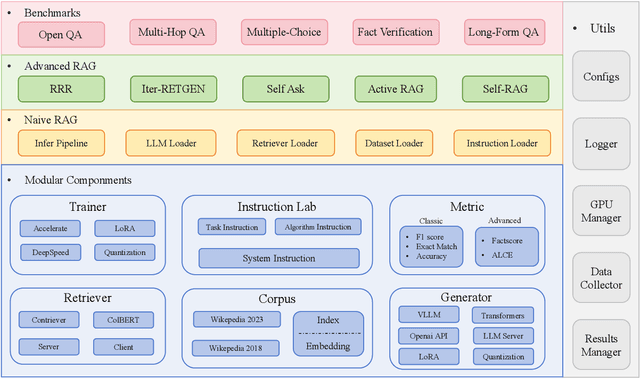

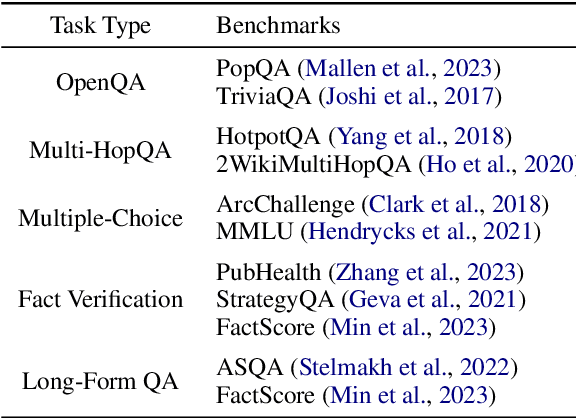
Abstract:Large Language Models (LLMs) demonstrate human-level capabilities in dialogue, reasoning, and knowledge retention. However, even the most advanced LLMs face challenges such as hallucinations and real-time updating of their knowledge. Current research addresses this bottleneck by equipping LLMs with external knowledge, a technique known as Retrieval Augmented Generation (RAG). However, two key issues constrained the development of RAG. First, there is a growing lack of comprehensive and fair comparisons between novel RAG algorithms. Second, open-source tools such as LlamaIndex and LangChain employ high-level abstractions, which results in a lack of transparency and limits the ability to develop novel algorithms and evaluation metrics. To close this gap, we introduce RAGLAB, a modular and research-oriented open-source library. RAGLAB reproduces 6 existing algorithms and provides a comprehensive ecosystem for investigating RAG algorithms. Leveraging RAGLAB, we conduct a fair comparison of 6 RAG algorithms across 10 benchmarks. With RAGLAB, researchers can efficiently compare the performance of various algorithms and develop novel algorithms.
SOAP: Enhancing Spatio-Temporal Relation and Motion Information Capturing for Few-Shot Action Recognition
Jul 24, 2024



Abstract:High frame-rate (HFR) videos of action recognition improve fine-grained expression while reducing the spatio-temporal relation and motion information density. Thus, large amounts of video samples are continuously required for traditional data-driven training. However, samples are not always sufficient in real-world scenarios, promoting few-shot action recognition (FSAR) research. We observe that most recent FSAR works build spatio-temporal relation of video samples via temporal alignment after spatial feature extraction, cutting apart spatial and temporal features within samples. They also capture motion information via narrow perspectives between adjacent frames without considering density, leading to insufficient motion information capturing. Therefore, we propose a novel plug-and-play architecture for FSAR called Spatio-tempOral frAme tuPle enhancer (SOAP) in this paper. The model we designed with such architecture refers to SOAP-Net. Temporal connections between different feature channels and spatio-temporal relation of features are considered instead of simple feature extraction. Comprehensive motion information is also captured, using frame tuples with multiple frames containing more motion information than adjacent frames. Combining frame tuples of diverse frame counts further provides a broader perspective. SOAP-Net achieves new state-of-the-art performance across well-known benchmarks such as SthSthV2, Kinetics, UCF101, and HMDB51. Extensive empirical evaluations underscore the competitiveness, pluggability, generalization, and robustness of SOAP. The code is released at https://github.com/wenbohuang1002/SOAP.
Leveraging Machine-Generated Rationales to Facilitate Social Meaning Detection in Conversations
Jun 27, 2024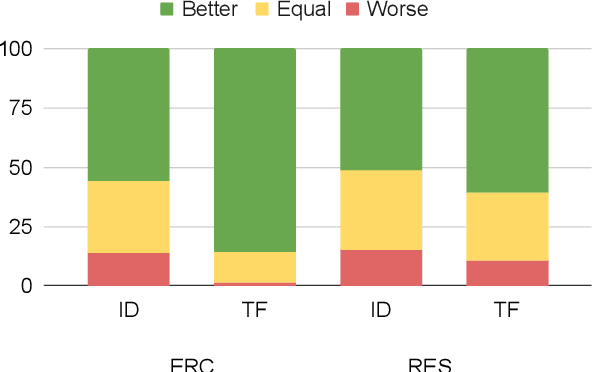
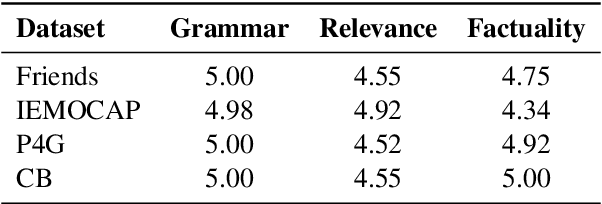
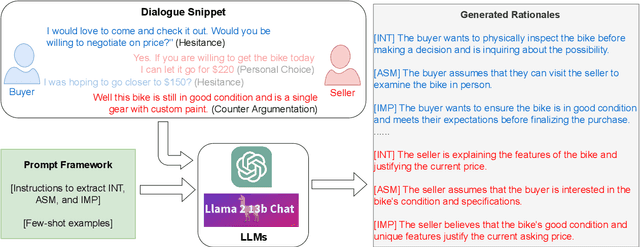

Abstract:We present a generalizable classification approach that leverages Large Language Models (LLMs) to facilitate the detection of implicitly encoded social meaning in conversations. We design a multi-faceted prompt to extract a textual explanation of the reasoning that connects visible cues to underlying social meanings. These extracted explanations or rationales serve as augmentations to the conversational text to facilitate dialogue understanding and transfer. Our empirical results over 2,340 experimental settings demonstrate the significant positive impact of adding these rationales. Our findings hold true for in-domain classification, zero-shot, and few-shot domain transfer for two different social meaning detection tasks, each spanning two different corpora.
Human-Object Interaction from Human-Level Instructions
Jun 25, 2024

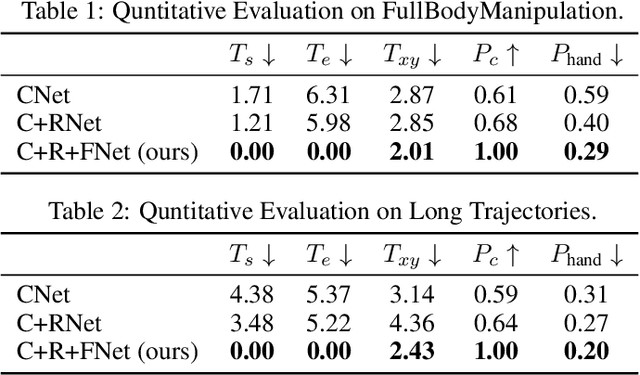
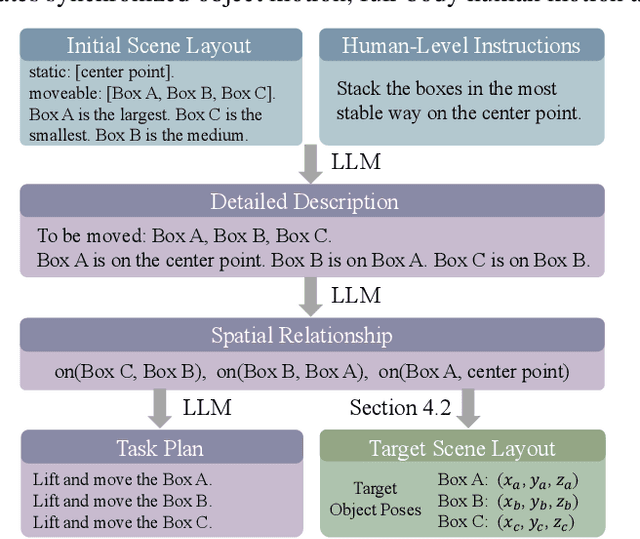
Abstract:Intelligent agents need to autonomously navigate and interact within contextual environments to perform a wide range of daily tasks based on human-level instructions. These agents require a foundational understanding of the world, incorporating common sense and knowledge, to interpret such instructions. Moreover, they must possess precise low-level skills for movement and interaction to execute the detailed task plans derived from these instructions. In this work, we address the task of synthesizing continuous human-object interactions for manipulating large objects within contextual environments, guided by human-level instructions. Our goal is to generate synchronized object motion, full-body human motion, and detailed finger motion, all essential for realistic interactions. Our framework consists of a large language model (LLM) planning module and a low-level motion generator. We use LLMs to deduce spatial object relationships and devise a method for accurately determining their positions and orientations in target scene layouts. Additionally, the LLM planner outlines a detailed task plan specifying a sequence of sub-tasks. This task plan, along with the target object poses, serves as input for our low-level motion generator, which seamlessly alternates between navigation and interaction modules. We present the first complete system that can synthesize object motion, full-body motion, and finger motion simultaneously from human-level instructions. Our experiments demonstrate the effectiveness of our high-level planner in generating plausible target layouts and our low-level motion generator in synthesizing realistic interactions for diverse objects. Please refer to our project page for more results: https://hoifhli.github.io/.
 Add to Chrome
Add to Chrome Add to Firefox
Add to Firefox Add to Edge
Add to Edge